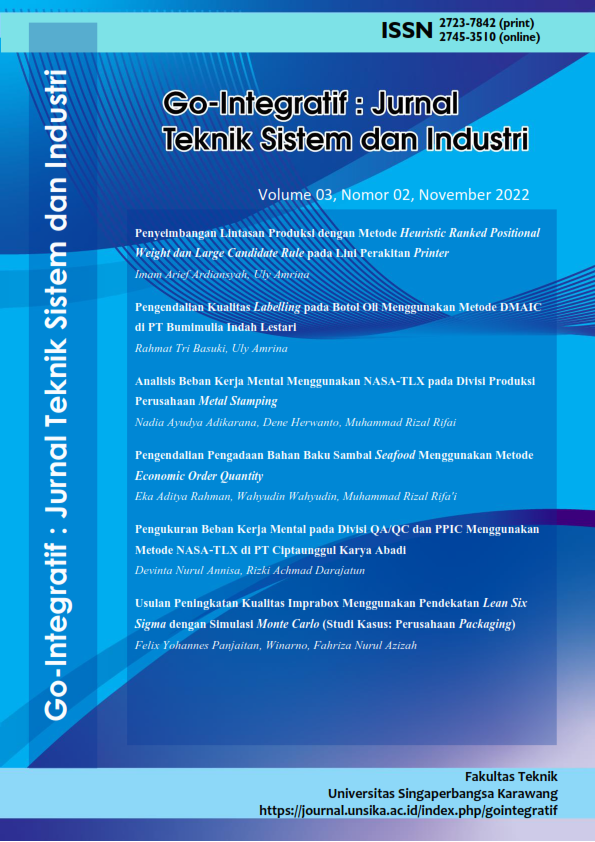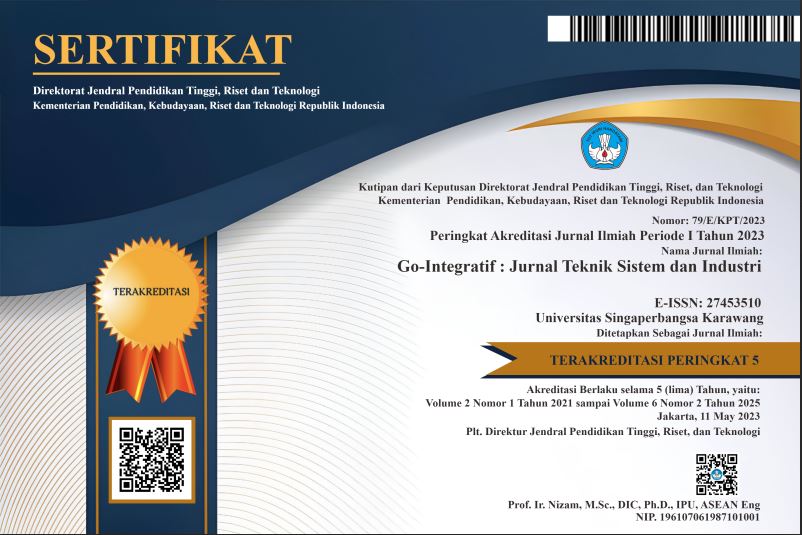Usulan Peningkatan Kualitas Imprabox Menggunakan Pendekatan Lean Six Sigma dengan Simulasi Monte Carlo (Studi Kasus: Perusahaan Packaging)
DOI:
https://doi.org/10.35261/gijtsi.v3i02.7565Abstract
The tight competition in the industry at this time makes every company must improve the quality of each product. To optimize the production process, waste becomes the main inhibiting factor that can reduce the company's image. PT Jaya Prakarsa is a packaging company which is currently facing the problem of the emergence of waste in each of its production processes for the final product which is called Imprabox. This study aims to reduce waste in the Imprabox production process using the lean six sigma method with the Define, Measure, Analyze, Improve & Control (DMAIC) stages and Monte Carlo simulation. The results of the define stage show that the defect waste becomes critical waste with a value of 42.3%. At the measure stage, the results from the p control chart show that the existing quality is still not fully controlled. The sigma level for the average process from February to March 2022 is 2.63 and the Process capability index (Cpk) value is 0.1532. This Cpk value is still less than 1.31, indicates that the company lacks production process capability. The cause and effect of the emergence of defects are then analyzed using a fishbone diagram at the analyze stage which will be repaired using 5W + 1H at the improve stage. Based on the results of the MC simulation with three successful scenarios of quality improvement of 50%, 75% and 100%, it shows that there is an increase in the processing capability for the company by 403.9%, 425.5%, and 426.9%, respectively.
Downloads
References
E. P. Lestari and I. W. S. Utami, “Analisis Kinerja Industri Manufaktur di Indonesia,” J. Ris. Ekon. dan Manaj., vol. 17, no. 1, p. 183, May 2017, doi: 10.17970/jrem.17.170115.ID.
M. Kholil and T. Pambudi, “Implementasi Lean Six Sigma dalam Peningkatan Kualitas dengan Mengurangi Produk Cacat NG Drop di Mesin Final Test Produk HL 4.8 di PT. SSI,” J. PASTI (Penelitian dan Apl. Sist. dan Tek. Ind., vol. 8, no. 1, pp. 14–29, 2014.
A. S. Rusdianto, N. Novijanto, and R. Alihsany, “Penerapan Statistical Quality Control (SQC) pada Pengolahan Kopi Robusta Cara Semi Basah,” J. Agroteknologi, vol. 5, no. 2, pp. 1–10, 2011.
R. Novitasari and I. Iftadi, “Analisis Lean Manufacturing untuk Minimasi Waste pada Proses Door PU,” J. INTECH Tek. Ind. Univ. Serang Raya, vol. 6, no. 1, pp. 65–74, Jun. 2020, doi: 10.30656/intech.v6i1.2045.
A. Naro and N. Halimah, “Perancangan Lean Production System pada Lini Produksi Panel Listrik Tipe Wall Mounting dengan Menggunakan Value Stream Mapping,” J. PASTI (Penelitian dan Apl. Sist. dan Tek. Ind., vol. 13, no. 1, pp. 61–71, 2019.
A. H. Najib, M. Choiri, and C. F. M. Tantrika, “Implementasi Lean Six Sigma Sebagai Upaya Meminimasi Waste pada Pembuatan Webb di PT. Temprina Media Grafika Nganjuk,” J. Rekayasa dan Manaj. Sist. Ind., vol. 2, no. 5, pp. 974–984, 2014.
R. D. Astuti and L. Lathifurahman, “Aplikasi Lean Six-Sigma untuk Mengurangi Pemborosan di Bagian Packaging Semen,” JISI J. Integr. Sist. Ind., vol. 7, no. 2, p. 143, Sep. 2020, doi: 10.24853/jisi.7.2.143-153.
P. Pangestu and F. Fahma, “Implementasi Six Sigma dalam Peningkatan Kualitas Proses Produksi LED TV di PT Sharp Electronics Indonesia,” PERFORMA Media Ilm. Tek. Ind., vol. 17, no. 2, Jul. 2019, doi: 10.20961/performa.17.2.30178.
L. Pasca Riani and M. R. Afandi, “Forecasting Demand Produk Batik Di Tengah Pandemi Covid-19 Studi Pada Usaha Batik Fendy, Klaten,” J. Nusant. Apl. Manaj. Bisnis, vol. 5, no. 2, pp. 122–132, Oct. 2020, doi: 10.29407/nusamba.v5i2.14441.
D. R. Indah and E. Rahmadani, “Sistem Forecasting Perencanaan Produksi dengan Metode Single Eksponensial Smoothing pada Keripik Singkong Srikandi Di Kota Langsa,” J. Penelit. Ekon. Akunt., vol. 2, no. 1, pp. 10–18, 2018.
V. Gaspersz, "Total Quality Management, Penerbit PT," Gramedia Pustaka Utama, 2001.
Downloads
Published
How to Cite
Issue
Section
License
Copyright (c) 2022 6. 7565-File Utama Naskah-Author revised3 - edited.pdf

This work is licensed under a Creative Commons Attribution-NonCommercial-ShareAlike 4.0 International License.







